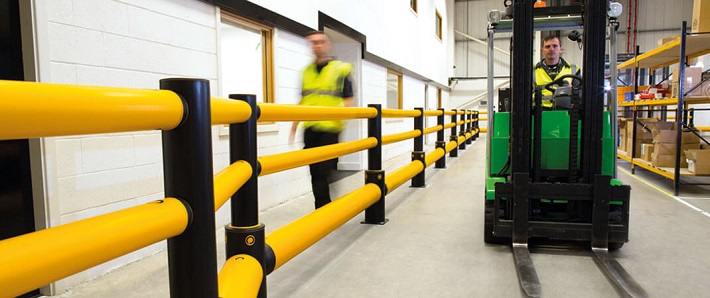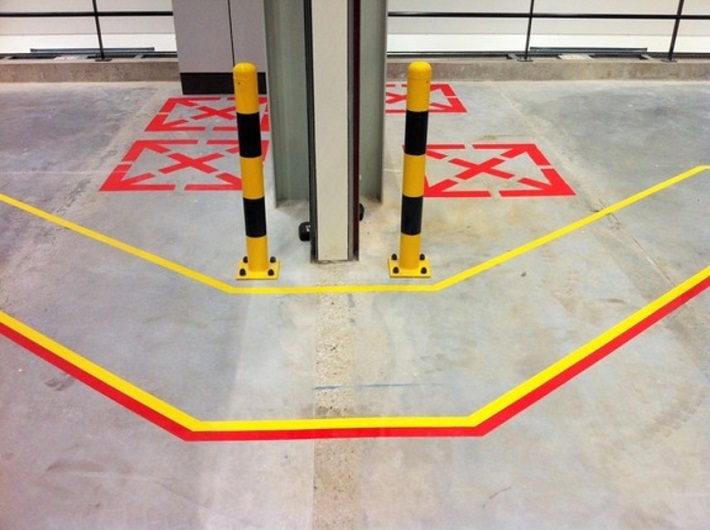Warehouse traffic and safety management are one of the most important factors when it comes to keeping the workplace free of health and safety risks. Warehouse vehicles and load transportation equipment, loading and unloading products are often linked to injuries and death to employees and people in the workplace. Traffic includes forklifts, delivery trucks and even cars, and when you take into account that the average warehouse can have hundreds of workers and visitors at the same time, not having the appropriate traffic safety supply products in place is a recipe for disaster. The best way to eliminate potential traffic hazards and protect pedestrians is by designing a layout of the warehouse to eliminate interaction between vehicles and pedestrians.

source: emtek.co.uk
While sometimes eliminating the risks completely isn’t possible, you should look to minimise them. The key issues you have to consider when managing warehouse traffic are pedestrian safety and them working with vehicles, using powered load shifting equipment, signs, warning and visibility devices, a proper layout of the work area and developing a traffic management plan. Warehouse managers and owners have a duty to make sure workers and other people present on the worksite aren’t exposed to safety and health risks from everyday operations.
Certain pieces of traffic safety supply equipment, such as warning signs, are an easy way to remind people of the possible traffic hazards. These supplies can be used to prohibit pedestrians from moving around a forklift operating area, indicate pedestrian safety zones, prohibit powered load shifting and forklift equipment from an area, etc. Proper lighting can also improve visibility on blind spots, in poor weather, etc. Other control measures can also be included, such as installing reversing cameras, sensors, mirrors and alarms on the warehouse vehicles to help drivers see potential pedestrian movement around them.

source: graphicproducts.com
Visual warning devices and high-visibility markings can also help forklift operators maneuver safely around the workplace. Of course, you’ll want to appoint trained staff to operate the forklift. Personal safety equipment (PPE), such as reflective clothing should also be work by workers and visitors to make themselves more visible to plant operators. Communication is also a big factor in workplace safety, and communication methods such as radios, line of sign communication (cap lamp light and hand signals), verbal communication and confirmation of warnings and signals should also be acknowledged.
But all of this can be in vain if there isn’t an appropriate traffic management plan that’s understood by everyone in the workplace. having designated travel paths for all of your warehouse vehicles, including exit and entry points, and traffic crossing other streams of traffic are also important. You need specific pedestrian traffic routes, and have traffic control measures for every expected interactions between vehicles and pedestrians. Everyone in the workplace needs to be aware of the layout of walkways, barriers, signs and other general arrangements to guide traffic and warn people of incoming traffic.

source: elevaciontotal.es
Management needs to put out procedures or instructions for controlling warehouse traffic in everyday operations, as well as in emergency situations. And lastly, the implementation and monitoring the effectiveness of the traffic management plan is also something that shouldn’t be overlooked. If any accidents do occur, the traffic management layout should be reviewed and adjustments need to be made to prevent the same accident from happening again. Worker training, instruction, supervision and site induction should all be included in the traffic management plan.
The general layout of the workplace, as aforementioned, is another important factor to consider. The control measures should include minimising intersections, cross-flow of traffic and eliminating blind spots. Customer pick up parking areas should be clearly defined and positioned in a manner that can be accessed without crossing loading dock paths or driveways. Pedestrian walkways should be marked using temporary barriers to separate powered plant operating areas and pedestrians, where they interact based on stopping distances, speed limits and efficient workflow.
At the end of the day, pedestrian safety is the most important risk you should look to eliminate. This can be best done by using overhead walkways. However, this practice isn’t always possible, so you should look for other solutions, such as installing physical separation barriers and fences to keep pedestrians away from areas where powered plants or other vehicles are present. You can also use separate pedestrian doors at vehicle exits and entries into the buildings, use bollards of safety railings to prevent pedestrians from stepping out into traffic from blind spots.
Using safety measures like safety zones and walkways to protect drivers once they’ve left the delivery vans and trucks is also recommended, and engineering controls like zoning systems, interlocked gates, speed shields and proximity alarms should also be implemented. There are some areas where both pedestrians and vehicles need to be present. These areas include loading and unloading vehicles and containers, and you should use temporary high visibility barriers in them. Implementing and enforcing right of way that clearly indicate who’s supposed to give way and displaying site maps of the workplace to indicate flow of traffic are also important.
When it’s all said and done, every workplace has specific needs that need to be considered. There are many guides online that can help you prepare and implement the best practices. Following OSHA regulations, common safety standards and some common sense are necessary to the safety of everyone involved in the workplace. And as they say – it’s always better to prevent than cure, so make your workplace as risk- and hazard-proof as possible.



